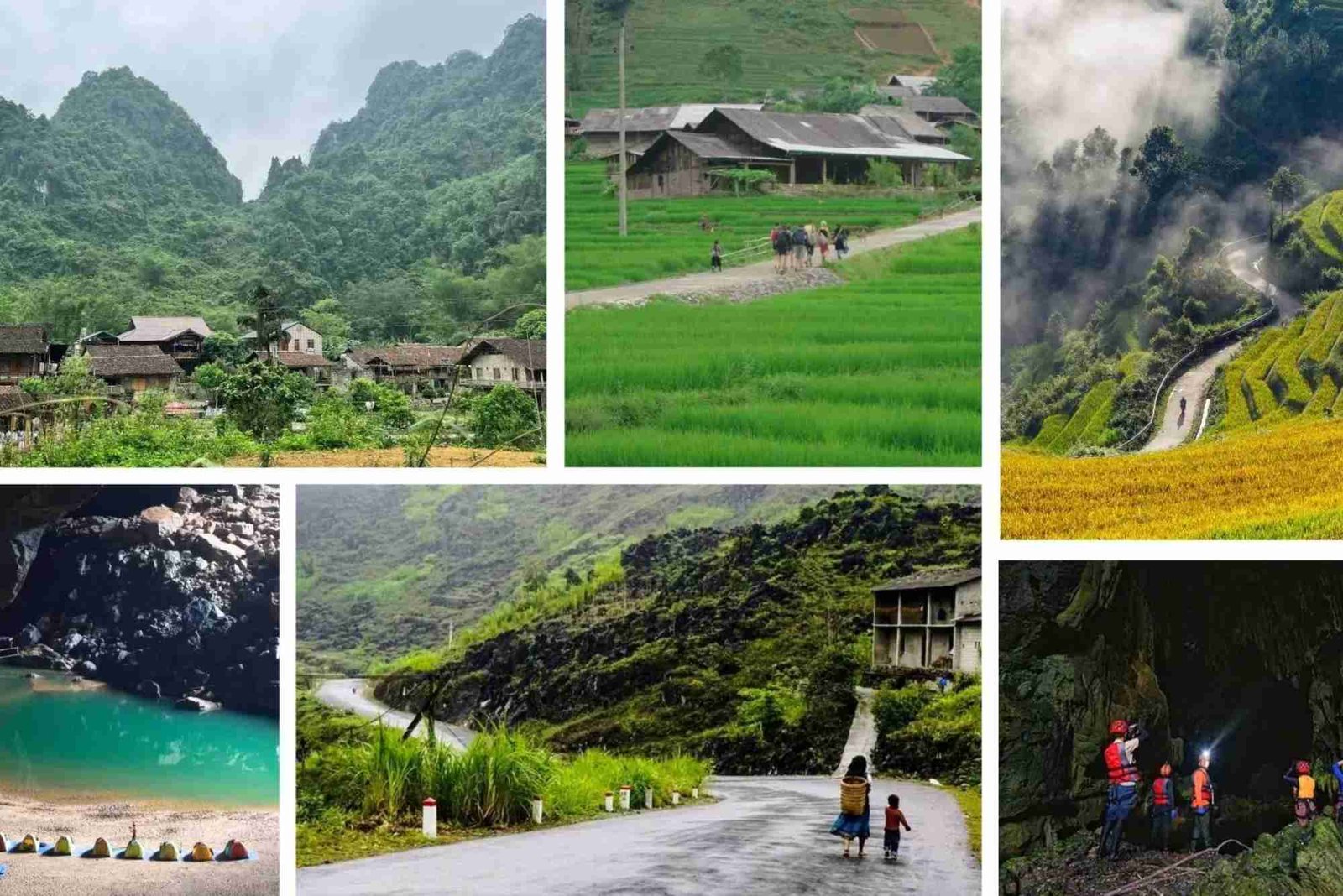Introduction
Vietnam is a hiker’s paradise, offering a rich combination of lush jungles, towering mountains, and breathtaking coastal paths. The country’s diverse terrain allows for hikes suitable for all experience levels, whether you are a beginner seeking gentle trails or an advanced hiker chasing challenging ascents. Exploring Vietnam on foot lets you immerse yourself in nature, encounter unique wildlife, and engage with local cultures in ways that ordinary travel cannot. This guide highlights the top 10 hikes in Vietnam, each offering a distinct experience, so you can plan a trip tailored to your abilities and preferences.
Fansipan Summit – The Roof of Indochina
Fansipan, the highest peak in Vietnam and Indochina at 3,143 meters, attracts adventure-seekers from across the globe. Located in the north near Sapa, this hike challenges even seasoned trekkers with steep ascents and unpredictable weather. The route passes through dense forests, terraced rice fields, and small villages, offering stunning panoramic views. Hikers should be prepared for a full-day trek, often taking two days if ascending from the base. While a cable car is available for those who prefer to bypass the strenuous climb, the traditional trek is deeply rewarding.
Ba Na Hills – Scenic Trails with French Charm
For a more relaxed experience, Ba Na Hills near Da Nang blends natural beauty with cultural charm. Famous for its Golden Bridge held by giant stone hands, the area offers several short to medium-length trails suitable for intermediate hikers. The trails wind through lush forests, flower gardens, and rolling hills, providing frequent photo opportunities. Temperate weather and well-maintained paths make this an excellent choice for families or travelers who enjoy a mix of nature and architectural interest.
Cat Ba National Park – Coastal and Jungle Trekking
Cat Ba Island, part of Ha Long Bay, is ideal for combining hiking with coastal scenery. The island’s national park contains dense tropical forests, limestone peaks, and diverse wildlife including langurs and exotic birds. Trails vary in difficulty, from easy walks along the coast to steep climbs leading to the park’s highest points. Hikers can enjoy the mix of jungle trekking and sea views, and overnight options in local villages allow for an authentic cultural experience.
Marble Mountains – Spiritual and Scenic Adventure
Just south of Da Nang, the Marble Mountains offer short but steep trails that are culturally rich and visually stunning. The hike involves climbing limestone hills dotted with caves, pagodas, and shrines, providing a spiritual dimension alongside natural beauty. Although the climbs are moderate, steps can be uneven, so sturdy shoes are recommended. Hikers are rewarded with panoramic views of the coast and city below, making this a perfect day-trip option.
Pu Luong Nature Reserve – Hidden Gem Trekking
Pu Luong Nature Reserve, located in Thanh Hoa Province, is a lesser-known destination that offers authentic rural hiking experiences. Terraced rice fields, bamboo forests, and remote villages create a scenic backdrop, perfect for hikers seeking tranquility. Trails range from gentle walks through villages to more demanding treks up hilltops, providing a balanced challenge for intermediate hikers. Local homestays enhance the journey, offering cultural insights and a chance to enjoy traditional Vietnamese hospitality.
Mount Lang Biang – Central Highlands Challenge
In the Central Highlands near Dalat, Lang Biang Mountain provides a moderate yet rewarding hike. Trails begin at the base near small villages and climb steadily through pine forests. The summit offers sweeping views of the surrounding valleys, lakes, and the city of Dalat. This hike suits beginners willing to challenge themselves with a few hours of uphill trekking. Guides are available, making navigation easier and enriching the hike with local stories.
Ho Chi Minh Trail Section Hikes – Historical Trekking
For those interested in history, certain sections of the Ho Chi Minh Trail in central and northern Vietnam offer immersive hiking experiences. These trails pass through dense forests, rugged mountains, and river crossings, echoing the paths used during wartime. Hikers can explore caves, relics, and old war routes while enjoying untouched nature. The difficulty varies, making some sections suitable for experienced trekkers and others accessible to moderate-level hikers. Guides are highly recommended for safety and historical context.
Son Tra Peninsula – Urban Jungle Hikes
Close to Da Nang, the Son Tra Peninsula combines coastal trails with urban proximity. Hikers traverse dense jungle paths, encounter rare monkeys, and reach viewpoints overlooking the South China Sea. Trails are generally moderate, with options for shorter hikes suitable for families or longer treks for fitness enthusiasts. The mix of wildlife, ocean views, and historical sites such as old French forts makes this hike unique and engaging.
Mai Chau Valley – Gentle Rural Trekking
For beginner hikers or those preferring leisurely walks, Mai Chau Valley in northern Vietnam offers serene landscapes of rice paddies and traditional stilt houses. Trails meander through local villages, allowing hikers to interact with the White Thai ethnic group and experience authentic rural life. The flat and accessible paths make it suitable for all ages while still providing a rich visual and cultural experience. Homestays and local cuisine add further depth to the trek.
Bach Ma National Park – Biodiverse Hiking
Bach Ma National Park, near Hue, is a biodiversity hotspot with trails ranging from easy to challenging. Hikers can explore waterfalls, lakes, and dense rainforest while spotting exotic flora and fauna. The park’s elevation provides cooler temperatures, and multiple trail options allow visitors to choose routes that match their fitness level. This area is perfect for intermediate hikers seeking natural beauty, wildlife encounters, and a chance to escape crowded tourist destinations.
Tips for Choosing the Right Hike in Vietnam
Choosing the right hike depends on your fitness level, experience, and what you want to experience. For beginners, Mai Chau Valley, Ba Na Hills, and Marble Mountains are excellent starting points. Intermediate hikers may enjoy Pu Luong, Lang Biang, and Son Tra Peninsula. For advanced trekkers, Fansipan and challenging sections of the Ho Chi Minh Trail provide the ultimate adventure. Always check weather conditions, carry sufficient water, and consider hiring local guides for safety and cultural insights. Proper footwear and layered clothing are essential due to varying terrains and climates.
Preparing for a Successful Hike
Preparation is key to enjoying Vietnam’s hikes. Carry a lightweight backpack with essentials such as water, snacks, first-aid kit, sun protection, and a rain jacket. Respect local customs and avoid littering, as many trails pass through sacred or protected areas. Engaging with local guides not only ensures safety but enhances your experience through storytelling, knowledge of local flora and fauna, and access to less-traveled paths. Start early to avoid midday heat, and pace yourself according to your fitness level. Photography is a must, but remember to prioritize safety over capturing the perfect shot.
Health and Safety Considerations
Vietnam’s diverse terrain poses different health and safety challenges. Tropical areas may contain insects, so insect repellent is recommended. Remote trails may have uneven terrain, requiring sturdy footwear and trekking poles for support. Ensure your vaccinations are up-to-date and carry necessary medications. Hydration is critical, and consuming only safe water or bottled water reduces the risk of illness. Paying attention to local warnings about wildlife, weather, and trail conditions ensures a safe and enjoyable hiking experience.
Why Hiking in Vietnam Is Unique
Vietnam offers an unparalleled combination of natural beauty, cultural richness, and accessible adventure. Hikes range from leisurely village walks to demanding mountain summits, providing something for everyone. The country’s dramatic landscapes, from limestone karsts to terraced rice fields, make every trail visually rewarding. Interactions with local communities, wildlife sightings, and historical insights make hiking more than just a physical activity—it becomes a journey of discovery.
Vietnam is a destination where hikers of all levels can find the perfect trail. From the highest peak of Fansipan to tranquil walks in Mai Chau Valley, the country offers unforgettable experiences that combine adventure, culture, and breathtaking scenery. Whether seeking challenging mountain ascents or serene rural paths, these top 10 hikes in Vietnam provide something for everyone. Plan your journey, respect local customs, and immerse yourself fully in the country’s natural and cultural wonders. Embrace the trails, and let Vietnam’s landscapes inspire your next adventure.
FAQ
What is the best time to hike in Vietnam?
The best time varies by region. Northern Vietnam is ideal from September to November, central regions from February to April, and the south year-round with dry season preference.
Are Vietnam hikes suitable for beginners?
Yes. Trails like Mai Chau Valley, Ba Na Hills, and Marble Mountains are beginner-friendly and offer scenic views with minimal difficulty.
Do I need a guide for hiking in Vietnam?
While not always required, guides enhance safety, provide cultural insights, and help navigate remote or challenging trails.
What should I pack for a hike in Vietnam?
Essentials include water, snacks, first-aid kit, sun protection, insect repellent, a rain jacket, proper footwear, and layered clothing for varying climates.
Are the hikes in Vietnam safe?
Yes, with precautions. Stay hydrated, follow trail signs, respect wildlife, and consider hiring a local guide for remote or challenging trails.




